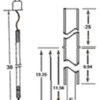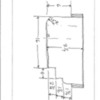I personally would go with what the dipstick says.
The qualification that I would use is that it is verified as a stock Pantera dipstick, original tube AND a stock Cleveland block.
I would test the capacity without changing the filter or filter like you have described above.
You need to keep in mind that normally there would be some oil retained in the heads themselves. How much? That can vary on the cylinder head that you are using since some of the aluminum heads were originally intended as racing heads and some of their designs include retaining oil near the springs since the springs usually need an oil bath to help cool them and reduce spring failure possibilities.
Remember the purpose of the bigger pans. It is to insure that under RACING conditions, you don't run the engine dry of oil and that you want to insure that not only on hard acceleration, deceleration and cornering g-loads.
With a stock Ford oil pan, that is possible at somewhere around 6,000 rpms.
Most clubs that I am aware of will recommend that one additional quart of oil be added to a stock pan for high speed running on a closed track event.
That is a safe consideration on a street car with a novice driver, not a professional race car and driver.
One additional quart above factory recommendations will put the level on the dipstick about 1/2" over the full level.
I've done this dozens of times at dozens of high speed events with novice drivers.
One "over full" quart NEVER hurt anyone on the track.
The issue of whether these pans are either 9 or 10 quarts capacity is a moot point. A half-inch over the full mark on the dipstick is not a serious issue.
A pan UNDER filled in which you are going to run this car for five continuous laps on a race track at as flat out as you can handle IS a serious issue if you run the pan dry.
MOST likely you will spin a rod bearing and that CAN mean you will wind up with a connecting rod failure that likely will get thrown through the side of the block.
If your engine is "burning oil" because it is one quart over filled is not likely. What IS likely is that your engine has OTHER issues.
Certainly a FLASHING RED LIGHT should go off that something is serious out of line if you are only taking 5 quarts to show full on a "10 quart pan".
Part of the issue here is that we are looking at pans of several different aftermarket manufacturers and we apparently are presuming that they are close to identical AND that all the manufacturers are using the same literal terminology. It would seem that the term "10 quart pan" is more of a generic term?
This in my observation is a similar situation as a novice with a "high performance/racing aftermarket" engine running on the street and expecting it to act like a regular street engine and have the same life expectancy as one.
The fact is it can break at any minute and possibly in a catastrophic way. That's why auto manufacturers don't offer "race engines" to the public. Venture into that at YOUR OWN RISK.
Here, experience is golden. It's like a fan coming out of the stands at Dodger Stadium and pinch hitting facing Bob Gibson or similar. "Look out. You can get killed out there". YOU and only you need to know what you are doing.
They are called "bumps of knowledge" but you have to survive them to make them worthwhile. As Billy Joel has sung, "you have no scars on your face".








